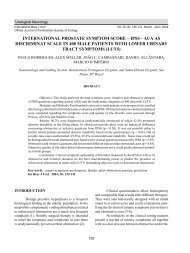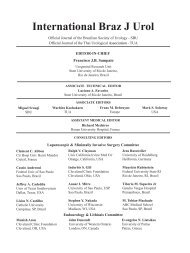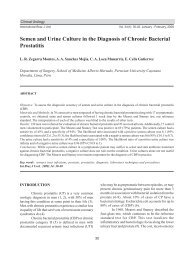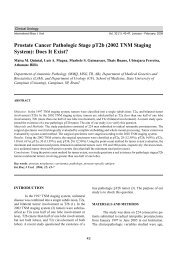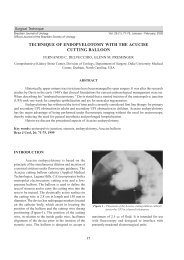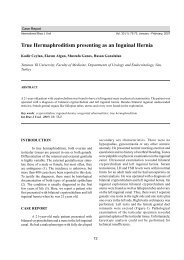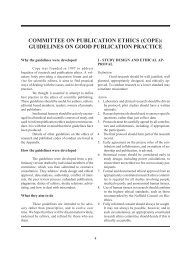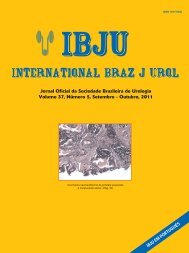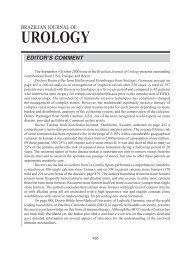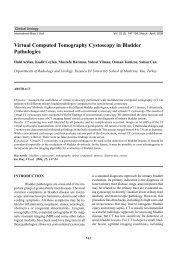Phyllanthus niruri as a Promising Alternative Treatment for ...
Phyllanthus niruri as a Promising Alternative Treatment for ...
Phyllanthus niruri as a Promising Alternative Treatment for ...
Create successful ePaper yourself
Turn your PDF publications into a flip-book with our unique Google optimized e-Paper software.
<strong>Phyllanthus</strong> <strong>niruri</strong> <strong>as</strong> <strong>Treatment</strong> <strong>for</strong> Nephrolithi<strong>as</strong>is<br />
Table 1 – Summary of main findings.<br />
Studies Main Findings Reference<br />
Models in vitro<br />
Models in vivo<br />
Clinical<br />
Inhibition of CaOx crystal adhesion and/or endocytosis<br />
Reduction in crystals aggregation<br />
Incre<strong>as</strong>e in COD <strong>for</strong>ms and reduced COM crystals<br />
Decre<strong>as</strong>ed rate of stone growth<br />
Incre<strong>as</strong>e intracrystalline amorphous organic matrix<br />
Changes in the shape and texture of the pre<strong>for</strong>med calculi<br />
Incre<strong>as</strong>ed calculi voiding<br />
Reduction in urinary calcium excretion in hypercalciuric patients<br />
Reduction in residual stone fragments after extracorporeal shock<br />
wave lithotripsy<br />
32<br />
24<br />
24<br />
34,35<br />
34<br />
35<br />
33<br />
36<br />
37<br />
COM = calcium oxalate monohydrate; COD = calcium oxalate dihydrate.<br />
3 months presented lower incidence of residual stone<br />
fragments, mainly those in lower calyceal location<br />
compared with non-treated patients. According to<br />
these investigators, the efficacy and the lack of side<br />
effects of <strong>Phyllanthus</strong> help improve overall outcomes<br />
after extracorporeal shock wave lithotripsy and could<br />
be useful <strong>as</strong> either an alternative or an adjunctive<br />
therapy in the treatment of urolithi<strong>as</strong>is.<br />
Table-1 summarizes the main findings in<br />
all studies. Given the experimental characteristic of<br />
these studies, except <strong>for</strong> the clinical ones (Grade of<br />
recommendation B), an exact level of evidence is not<br />
applicable.<br />
CONCLUSION AND PERSPECTIVES<br />
The experimental studies summarized here<br />
suggest that <strong>Phyllanthus</strong> <strong>niruri</strong> might interfere with<br />
important steps of the calculi <strong>for</strong>mation including<br />
crystal aggregation and internalization by the tubular<br />
cells, crystal structure and composition. These properties<br />
of <strong>Phyllanthus</strong> <strong>niruri</strong> may constitute an important<br />
advantage in the prevention of lithi<strong>as</strong>is, inhibiting<br />
calculus growth and keeping the crystals dispersed<br />
in the urine, with their consequent e<strong>as</strong>ier elimination.<br />
Although clinical studies are less abundant, available<br />
data point to beneficial effects of <strong>Phyllanthus</strong> by inducing<br />
ureteral relaxation, interfering in the excretion<br />
of promoters of urinary crystallization such <strong>as</strong> calcium<br />
or helping to clear fragments following lithotripsy. It<br />
is important to consider however, that although it is<br />
clear that <strong>Phyllanthus</strong> <strong>niruri</strong> can interfere with many<br />
steps of the stone <strong>for</strong>mation, longer-term clinical studies<br />
are necessary to define whether these effects can<br />
be translated into real clinical benefit to treat and/or<br />
prevent urolithi<strong>as</strong>is.<br />
CONFLICT OF INTEREST<br />
REFERENCES<br />
None declared.<br />
1. Moe OW: Kidney stones: pathophysiology and medical<br />
management. Lancet. 2006; 367: 333-44.<br />
2. Bartoletti R, Cai T, Mondaini N, Melone F, Travaglini<br />
F, Carini M, et al.: Epidemiology and risk factors in<br />
urolithi<strong>as</strong>is. Urol Int. 2007; 79(suppl) 1: 3-7.<br />
3. Pak CY, Resnick MI, Preminger GM: Ethnic and<br />
geographic diversity of stone dise<strong>as</strong>e. Urology. 1997;<br />
50: 504-7.<br />
4. Matlaga BR, Coe FL, Evan AP, Lingeman JE: The role<br />
of Randall’s plaques in the pathogenesis of calcium<br />
stones. J Urol. 2007; 177: 31-8.<br />
5. Kh<strong>as</strong>khali MH, Byer KJ, Khan SR: The effect of calcium<br />
on calcium oxalate monohydrate crystal-induced<br />
renal epithelial injury. Urol Res. 2009; 37: 1-6.<br />
662



